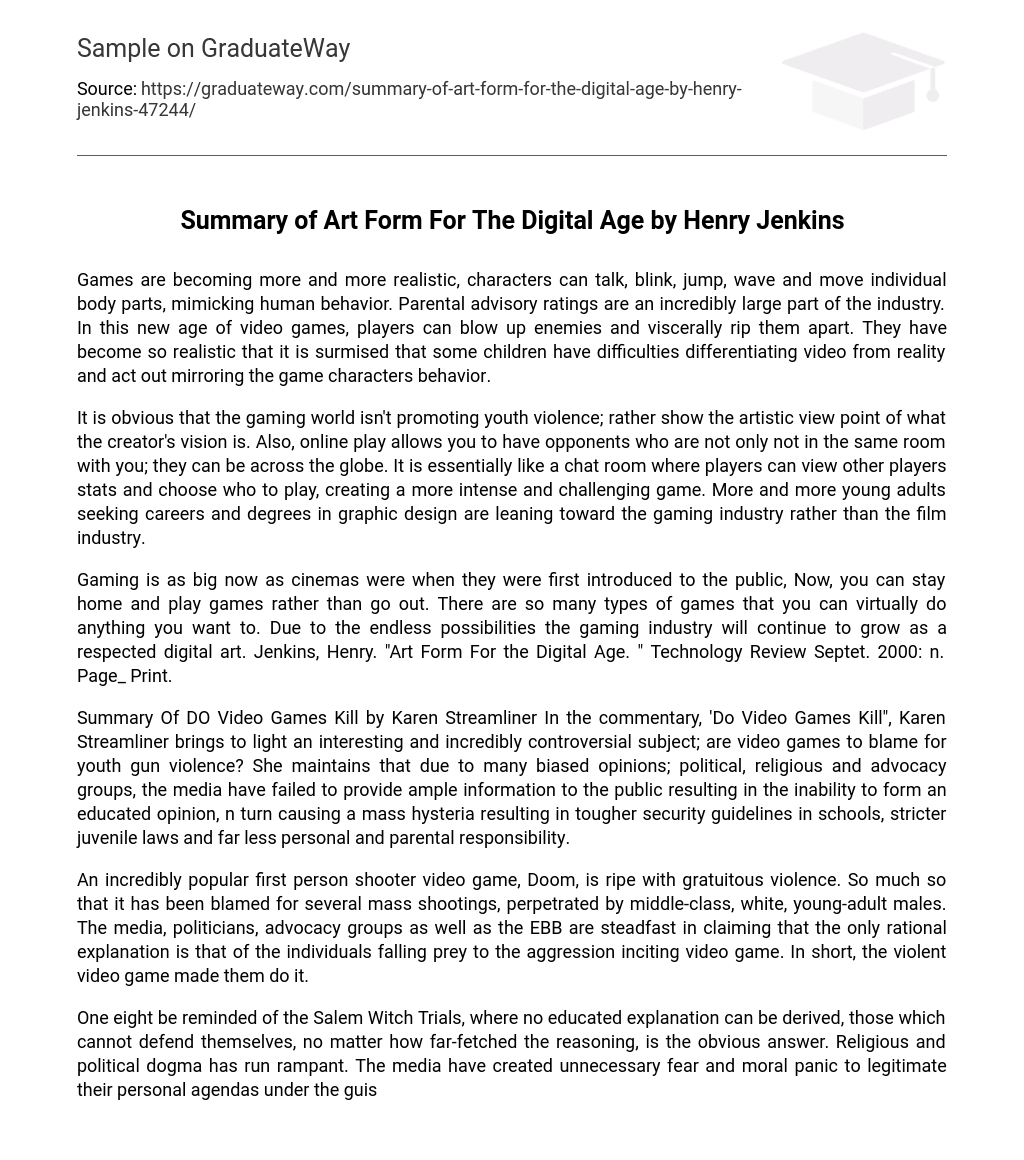Video games are becoming more realistic, with characters that can imitate human behavior by talking, blinking, jumping, waving, and moving individual body parts. The gaming industry heavily relies on parental advisory ratings. In today’s world of video games, players can engage in violent actions such as tearing apart enemies. These lifelike games have led some children to struggle differentiating between the virtual world and reality, potentially causing them to imitate the behavior of game characters.
Contrary to common beliefs about encouraging youth violence, the gaming industry provides a platform for expressing the artistic vision of its creators. Moreover, online gameplay allows players to engage with global opponents and access statistics akin to a chat room experience, resulting in more intense and demanding gameplay. Recently, an emerging trend among young adults pursuing graphic design careers or degrees is opting for the gaming industry instead of the film industry.
The popularity of gaming among the general public can be compared to the initial introduction of cinemas. Nowadays, individuals have the choice to stay home and play games instead of going out. The gaming industry provides a diverse range of games that allow people to virtually participate in any activity they desire. Due to its limitless potential, the gaming industry will continue prospering as a widely respected form of digital art (Jenkins, Henry. “Art Form For the Digital Age.” Technology Review Septet. 2000: n. Page_ Print.)
Karen Streamliner’s commentary, titled “Do Video Games Kill,” addresses the contentious issue of whether video games are responsible for youth gun violence. She highlights the lack of reliable information provided by the media, which has been influenced by biased opinions from political, religious, and advocacy groups. This limited information has caused mass panic and resulted in stricter security measures in schools, more stringent laws for juveniles, and reduced personal and parental accountability.
An immensely popular first-person shooter video game, Doom, is filled with excessive violence, to such an extent that it has been accused of causing multiple mass shootings committed by young white males of middle-class background. The media, politicians, advocacy groups, and the EBB all assert that the sole logical explanation is that these individuals became victims of the aggressive video game, thus attributing their actions to it. To put it succinctly, the violent video game influenced their behavior.
One may be reminded of the Salem Witch Trials, in which no rational explanation could be found. Those who were unable to defend themselves, regardless of how unlikely the accusations were, were automatically presumed guilty. Religious and political ideologies have become unchecked. The media has stoked unfounded fear and moral hysteria in order to further their own motives disguised as “protecting children”. Other explanations are often overlooked. Factors such as depression, poverty, lack of education, low self-esteem, bullying, and abusive households are rarely acknowledged and rarely investigated thoroughly.
The juvenile justice laws in almost every state have been revised to impose harsher penalties. The Supreme Court’s decision declaring juvenile executions unconstitutional has caused even greater concern among the fearful public. Ultimately, the author urges the reader to explore alternative explanations in order to educate and guide the masses away from solely blaming video games. Instead, the focus should shift towards considering socioeconomic and psychological factors that contribute to an individual’s violent behavior.
Summary of “In Defense of Hip-Hop” by Kathleen Rounded
Kathleen Rounded’s article “In Defense of Hip Hop” addresses the growing disregard for the genre and presents a solution to value, honor, and endorse hip-hop music. The article was published in the Journal of American Sociological Association Winter Contexts in 2007 and is authored by Streamliner, Karen. It can be located on page n and is accessible in print.
In addition, she contends that the art form is often misunderstood and immediately criticized by uneducated masses who lack a full understanding of it. These individuals are also unwilling to make an effort to comprehend it. Many sources attribute ignorance, crime, incarceration, disrespect, and the reinforcement of negative connotations and stereotypes to Hip Hop, highlighting the negative associations frequently attached to this often misunderstood art form.
Lyricists have faced rejection and exclusion from society and have been held accountable for the negative influence of modern pop-culture. However, upon closer examination, it is now evident that hip hop has also been associated with constructive media ventures, such as movies and team efforts where artists from diverse backgrounds come together to express their struggles and misfortunes through this genre of music. Similar to the beatniks of the 1950s, these artists strive to satisfy their desire for personal growth and self-exploration rather than promoting aggression.





